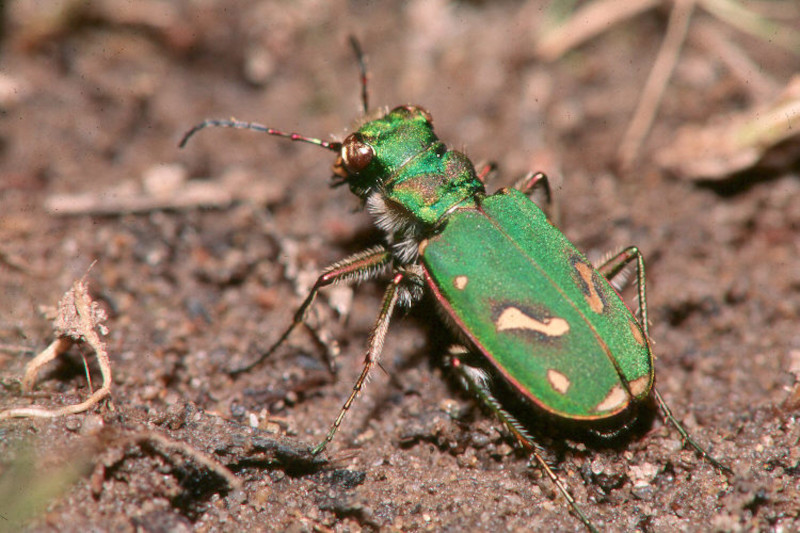Ohlone Tiger Beetle Facts
- This tantalizing product of Nature and evolution most frequently goes by the common name of the Ohlone Tiger Beetle. For the moment, this marvelous invertebrate has no other generally accepted common name. That’s partly due to a surprising fact, however.
- Despite existing in a densely populated part of the world, it wasn’t discovered until 1987. Even then, though, no organized research involving the Arthropod took place for an extended period, Due to that fact, the beetle wasn’t officially described until 1993.
- Scientific professionals, such as researchers, tend to refer to it by its formal name, though. The wonder of Nature only received that name following its description. That, though, is the somewhat similar, and not overly difficult, term of the Cicindela ohlone.
- The respected researchers, Freitag and Kavanaugh made the first acknowledgement of a separate and distinct species. This they subsequently published in a scientific journal. They further distinguished it from related species sharing the same habitat range.
- For the moment, the IUCN has no listing for it on its Red List. That lack of listing principally exists due to a lack of sufficient information on the insect. The species does, however, officially list as a Critically Imperiled species in the country where it lives.
- The Ohlone Tiger Beetle faces several threats to its continued existence. Habitat degradation, and outright loss, certainly qualifies as one. Invasive species of non-native flora also endanger it. Its greatest threat, though, consists of ongoing climate change.
Related Articles
Ohlone Tiger Beetle Physical Description
The magnificent Ohlone Tiger Beetle easily catches the eye of all those fortunate enough to encounter one. They do not do so, however, due to sheer physical size. That holds true since this work of natural forces evolved as a relatively tiny member of its impressive Order.
Researchers still know comparatively little about this intriguing Arthropod. Limited studies do indicate a few, basic facts about the invertebrate, though. One of these is that the animal displays only a slight degree of the physiological characteristic of sexual dimorphism.
In its specific case, this trait manifests itself in terms of sheer physical size. More specifically, the females attain a slightly greater averange body length than their male counterparts. Overall, individuals only reach a total size measuring between 0.37 – 0.5 in (0.94 – 1.3 cm).
Otherwise, specimens present the same external appearance, regardless of gender. The principal color scheme consists of a bright, metallic green background. Overlaid on this, though, comes a scattering of spots and elongated bronze patterns on parts of the body.
The Ohlone Tiger Beetle posseses an overall body shape strongly reminiscent of other tiger beetles. It closely resembles the Salt Creek Tiger Beetle, for example. It also has sharply prominent eyes, along with relatively long legs that display a coppery-green shade.
- Kingdom: Animalia
- Phylum: Arthropoda
- Class: Insecta
- Order: Coleoptera
- Family: Carabidae
- Genus: Cicindela
- Species: C. ohlone
Ohlone Tiger Beetle Distribution, Habitat, and Ecology
Unfortunately, the distinctive Ohlone Tiger Beetle apparently evolved as endemic to an extremely restricited zone of habitation. Evidence further indicates the strong possibility that its territorial range never extended beyond its current miniscule boundaries.
That’s true since it seems to have evolved as native to only a small portion of the continent of North America. That portion consists of a corner of what now forms the United States. But, even there, it’s limited to only part of Santa Cruz county, in California.
Its range is further limited, however, by its own preferences. Due to these, the insect only appears in on or adjacent to a single, highly specific, type of ecosystem. That extremely specific type of habitat consists of small, remaining regions of native coastal grasslands.
Yet, even within this already extraordinarily limited range, the remarkable beetle only lives in widely scattered concentrations. Among the rapidly vanishing, broadly scattered, patches of endemic grasslands, it only lives in a small percentage of the individual occurrences.
Even this fact is due to the nature of the biology of the Ohlone Tiger Beetle. The Arthropod additionally requires the presence of either sandy clay or poorly drained clay over local mudstone. During late spring and summer, this becomes packed and comparatively hard.
Like many of its relatives, this species evolved as highly predatory in nature. It feeds on a wide variety of small, locally available arthropods. Somewhat uniquely, it captures its prey by a combination or active hunting in addition to waiting in ambush for it to approach.
Species Sharing Its Range
Check out our other articles on 7 Deceptively Dazzling Deserts, Wilson’s Bird-of-paradise, Fraser Island, American Cranberrybush, New Guinea Crocodile, Swell Shark, Australian Sea Lion

